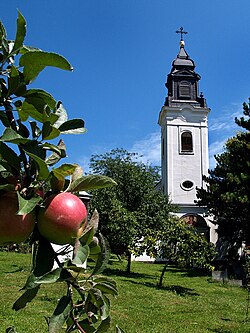Inđija
|
Inđija Инђија |
||
|---|---|---|
| Town and municipality | ||

The old Serbian Orthodox church
|
||
|
||
 Location of the municipality of Inđija within Serbia |
||
| Coordinates: 45°03′N 20°05′E / 45.050°N 20.083°ECoordinates: 45°03′N 20°05′E / 45.050°N 20.083°E | ||
| Country |
|
|
| Province | Vojvodina | |
| District | Srem | |
| Settlements | 11 | |
| Government | ||
| • Mayor | Vladimir Gak (SNS) | |
| Area | ||
| • Municipality | 384 km2 (148 sq mi) | |
| Population (2011 census) | ||
| • Town | 26,025 | |
| • Municipality | 47,433 | |
| Time zone | CET (UTC+1) | |
| • Summer (DST) | CEST (UTC+2) | |
| Postal code | 22320 | |
| Area code | +381 22 | |
| Car plates | IN | |
| Website |
www |
|
Inđija (Serbian Cyrillic: Инђија, pronounced [ǐndʑija]) is a town and a municipality located in the Srem District of the autonomous province of Vojvodina, Serbia. In 2011 the town has total population of 26,025 and its area is 384 km². The population of Inđija municipality is 47,433. It is located in the geographical region of Syrmia. The municipality has an 85% Serb majority and the town has an 87% Serb majority.
According to the legend, the name of the town comes from Turkish word "ikindia" – meaning evening prayer and is related to the time after 1699 when the town fell under Turkish rule. On the other hand, there is the claim that the town was named after the name of Orthodox women – Indjija.In Serbian, the town is known as Inđija (Инђија), in Croatian as Inđija, in Hungarian as Ingyia, in German as India, in Slovak as India or Indjija, and in Rusyn as Индїя.
The first verifiable evidence of Inđija's existence is in the Charter of Despot Jovan Branković from 1496, but it may have existed as early as 1455 as possession of Hungarian noble family Sulyok. During the Ottoman administration (16th-18th centuries), Inđija was mostly populated by ethnic Serbs, and was part of the Ottoman Sanjak of Syrmia.
Since 1717, Inđija was part of the Habsburg Monarchy, and became a feudal domain of Count Marko Pejačević of the Pejačević family that originated from Chiprovtsi, Bulgaria. The old medieval Inđija was placed a little bit to the north than today town. The present-day Inđija was founded by the Serb settlers from Beška and Patka in 1746. According to the description from 1746 it had 60 households, while in 1791 it has already grown to 122 households with 1,054 residents. In the second half of the 18th century, this new settlement was mostly populated by ethnic Serbs. Germans and Czechs start settling in Inđija at the beginning of the 19th century, while Hungarians migrated there towards the end of the century. During the time, Germans became dominant population in the town.
...
Wikipedia

